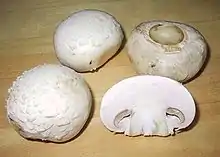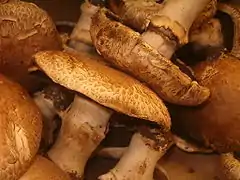Agaricus bisporus
Agaricus bisporus is an edible basidiomycete mushroom native to grasslands in Europe and North America. It has two color states while immature – white and brown – both of which have various names, with additional names for the mature state.
| Agaricus bisporus | |
|---|---|
 | |
| Scientific classification | |
| Kingdom: | Fungi |
| Division: | Basidiomycota |
| Class: | Agaricomycetes |
| Order: | Agaricales |
| Family: | Agaricaceae |
| Genus: | Agaricus |
| Species: | A. bisporus |
| Binomial name | |
| Agaricus bisporus (J.E.Lange) Imbach (1946)[1] | |
| Synonyms | |
| |
| Agaricus bisporus | |
|---|---|
| gills on hymenium | |
| cap is convex | |
| hymenium is free | |
| stipe has a ring | |
| spore print is brown | |
| ecology is saprotrophic | |
| edibility: edible | |
A. bisporus is cultivated in more than seventy countries[2] and is one of the most commonly and widely consumed mushrooms in the world.
Names
When immature and white, this mushroom may be known as:
- common mushroom
- white mushroom[3]
- button mushroom[3]
- cultivated mushroom
- table mushroom
- champignon (French for mushroom)
When immature and brown, it may be known variously as:
- Swiss brown mushroom
- Roman brown mushroom
- Italian brown mushroom
- cremini/crimini mushroom[4][5]
- chestnut mushroom (not to be confused with Pholiota adiposa)
- baby bella[4]
When marketed in its mature state, the mushroom is brown with a cap measuring 10–15 centimetres (4–6 inches).[5] This form is commonly sold under the names portobello,[5][6] portabella,[7] or portobella; the etymology is disputed.[5][6]
Taxonomy
The common mushroom has a complicated taxonomic history. It was first described by English botanist Mordecai Cubitt Cooke in his 1871 Handbook of British Fungi, as a variety (var. hortensis) of Agaricus campestris.[8][9] Danish mycologist Jakob Emanuel Lange later reviewed a cultivar specimen, and dubbed it Psalliota hortensis var. bispora in 1926.[10] In 1938, it was promoted to species status and renamed Psalliota bispora.[11] Emil Imbach (1897–1970) imparted the current scientific name of the species, Agaricus bisporus, after the genus Psalliota was renamed to Agaricus in 1946.[2] The specific epithet bispora distinguishes the two-spored basidia from four-spored varieties.
Description
The pileus or cap of the original wild species is a pale grey-brown in color, with broad, flat scales on a paler background and fading toward the margins. It is first hemispherical in shape before flattening out with maturity, and 5–10 centimetres (2–4 inches) in diameter. The narrow, crowded gills are free and initially, pink, then red-brown and finally a dark brown with a whitish edge from the cheilocystidia. The cylindrical stipe is up to 6 cm (2+1⁄2 in) tall by 1–2 cm (1⁄2–3⁄4 in) wide and bears a thick and narrow ring, which may be streaked on the upper side. The firm flesh is white, although stains a pale pinkish-red on bruising.[12][13] The spore print is dark brown. The spores are oval to round and measure approximately 4.5–5.5 μm × 5–7.5 μm, and the basidia usually two-spored, although two-tetrasporic varieties have been described from the Mojave Desert and the Mediterranean, with predominantly heterothallic and homothallic lifestyles, respectively.[14][15]
This mushroom is commonly found worldwide in fields and grassy areas following rain, from late spring through to autumn, especially in association with manure. In many parts of the world it is widely collected and eaten; however, there is a resemblance to deadly or poisonous lookalikes (see below).
Lookalike species
The common mushroom could be confused with young specimens of the deadly poisonous destroying angel (Amanita sp.), but the latter may be distinguished by their volva or cup at the base of the mushroom and pure white gills (as opposed to pinkish or brown of A. bisporus). Furthermore, the destroying angel grows in mossy woods and lives symbiotically with spruce.
A more common and less dangerous mistake is to confuse A. bisporus with Agaricus xanthodermus, an inedible mushroom found worldwide in grassy areas. A. xanthodermus has an odor reminiscent of phenol; its flesh turns yellow when bruised. This fungus causes nausea and vomiting in some people.
The poisonous European species Entoloma sinuatum has a passing resemblance as well, but has yellowish gills, turning pink, and it lacks a ring.
Cultivation history

| Mushroom and truffle production – 2019 | |
|---|---|
| Country | Millions of tonnes |
| 8.94 | |
| 0.47 | |
| 0.38 | |
| 0.36 | |
| 0.30 | |
| World | 11.90 |
| Source: FAOSTAT of the United Nations[16] | |
The earliest scientific description of the commercial cultivation of A. bisporus was made by French botanist Joseph Pitton de Tournefort in 1707.[17] French agriculturist Olivier de Serres noted that transplanting mushroom mycelia would lead to the propagation of more mushrooms.
Originally, cultivation was unreliable as mushroom growers would watch for good flushes of mushrooms in fields before digging up the mycelium and replanting them in beds of composted manure or inoculating 'bricks' of compressed litter, loam, and manure. Spawn collected this way contained pathogens and crops commonly would be infected or not grow at all.[18] In 1893, sterilized, or pure culture, spawn was discovered and produced by the Pasteur Institute in Paris, for cultivation on composted horse manure.[19]
Modern commercial varieties of the common agaricus mushroom originally were light brown in color. The white mushroom was discovered in 1925 growing among a bed of brown mushrooms at the Keystone Mushroom Farm in Coatesville, Pennsylvania. Louis Ferdinand Lambert, the farm's owner and a mycologist by training, brought the white mushroom back to his laboratory. As with the reception of white bread, it was seen as a more attractive food item and became grown and distributed.[20] Similar to the commercial development history of the navel orange and Red Delicious apple, cultures were grown from the mutant individuals, and most of the cream-colored store mushrooms marketed today are products of this 1925 chance natural mutation.
A. bisporus is now cultivated in at least seventy countries throughout the world.[2]
In the U.S., the white button form of A. bisporus alone accounts for about 90% of mushrooms sold.[3]
Nutritional profile
| Nutritional value per 100 g (3.5 oz) | |
|---|---|
| Energy | 93 kJ (22 kcal) |
3.26 g | |
| Sugars | 1.98 g |
| Dietary fiber | 1 g |
0.34 g | |
Protein | 3.09 g |
| Vitamins | Quantity %DV† |
| Thiamine (B1) | 7% 0.081 mg |
| Riboflavin (B2) | 34% 0.402 mg |
| Niacin (B3) | 24% 3.607 mg |
| Pantothenic acid (B5) | 30% 1.497 mg |
| Vitamin B6 | 8% 0.104 mg |
| Folate (B9) | 4% 17 μg |
| Vitamin B12 | 2% 0.04 μg |
| Vitamin C | 3% 2.1 mg |
| Vitamin D | 1% 0.2 μg |
| Minerals | Quantity %DV† |
| Iron | 4% 0.5 mg |
| Magnesium | 3% 9 mg |
| Phosphorus | 12% 86 mg |
| Potassium | 7% 318 mg |
| Sodium | 0% 3 mg |
| Zinc | 5% 0.52 mg |
| Other constituents | Quantity |
| Water | 92.45 g |
| |
| †Percentages are roughly approximated using US recommendations for adults. Source: USDA FoodData Central | |
In a 100-gram serving, raw white mushrooms provide 93 kilojoules (22 kilocalories) of food energy and are an excellent source (> 19% of the Daily Value, DV) of the B vitamins, riboflavin, niacin, and pantothenic acid (table). Fresh mushrooms are also a good source (10–19% DV) of the dietary mineral phosphorus (table).
While fresh A. bisporus only contains 0.2 micrograms (8 IU) of vitamin D as ergocalciferol (vitamin D2), the ergocalciferol content increases substantially after exposure to UV light.[21][22]
Gallery
 White Agaricus bisporus
White Agaricus bisporus.jpg.webp) Two Agaricus bisporus mushrooms that have fused together
Two Agaricus bisporus mushrooms that have fused together Portobello mushrooms
Portobello mushrooms Cross-section of a portobello cultivar
Cross-section of a portobello cultivar Ventral view of a portobello cultivar with a bisected stipe
Ventral view of a portobello cultivar with a bisected stipe
See also
- Fungiculture
- List of Agaricus species
References
- Imbach EJ (1946). "Pilzflora des Kantons Luzern und der angrenzen Innerschweiz". Mitteilungen der naturforschenden Gesellschaft Luzern (in German). 15: 5–85.
- Cappelli A. (1984). Fungi Europaei:Agaricus (in Italian). Saronno, Italy: Giovanna Biella. pp. 123–25.
- "White Button". Fresh Mushrooms. Mushroom Council. n.d. Archived from the original on 29 February 2020. Retrieved 29 February 2020.
- "Crimini". Fresh Mushrooms. Mushroom Council. n.d. Archived from the original on 7 August 2022. Retrieved 29 February 2020.
- GourmetSleuth (11 November 2013). "Portobello (Portobella) Mushrooms". Gourmet Sleuth. Archived from the original on 10 January 2019. Retrieved 9 January 2019.
- "portobello | Definition of portobello by Lexico". Lexico Dictionaries | English. Archived from the original on 31 August 2019. Retrieved 31 August 2019.
- "Portabella". Fresh Mushrooms. Mushroom Council. n.d. Archived from the original on 29 February 2020. Retrieved 29 February 2020.
- Cooke MC (1871). Handbook of British Fungi. Vol. 1. London: Macmillan and Co. p. 138.
- "Species Fungorum – Species synonymy". Index Fungorum. CAB International. Archived from the original on 10 June 2011. Retrieved 21 January 2010.
- Lange JE (1926). "Studies in the agarics of Denmark. Part VI. Psalliota, Russula". Dansk Botanisk Arkiv. 4 (12): 1–52.
- Schäffer J, Møller FH (1939). "Beitrag zur Psalliota Forschung". Annales Mycologici (in German). 36 (1): 64–82.
- Zeitlmayr L (1976). Wild Mushrooms:An Illustrated Handbook. Garden City Press, Hertfordshire. pp. 82–83. ISBN 0-584-10324-7.
- Carluccio A. (2003). The Complete Mushroom Book. Quadrille. ISBN 1-84400-040-0.
- Callac P, Billette C, Imbernon M, Kerrigan RW (1993). "Morphological, genetic, and interfertility analyses reveal a novel, tetrasporic variety of Agaricus bisporus from the Sonoran Desert of California". Mycologia. 85 (5): 835–851. doi:10.2307/3760617. JSTOR 3760617.
- Callac P, Imbernon M, Guinberteau J, Pirobe L, Granit S, Olivier JM, Theochari I (2000). "Discovery of a wild Mediterranean population of Agaricus bisporus, and its usefulness for breeding work". Mushroom Science. 15: 245–252.
- "Production of mushrooms and truffles in 2019, Crops/Regions/World list/Production Quantity (pick lists)". UN Food and Agriculture Organization, Corporate Statistical Database (FAOSTAT). 2020. Archived from the original on 12 November 2016. Retrieved 3 March 2021.
- Spencer DM (1985). "The mushroom–its history and importance". In Flegg PB, Spencer DM, Wood DA (eds.). The Biology and Technology of the Cultivated Mushroom. New York: John Wiley and Sons. pp. 1–8. ISBN 0-471-90435-X.
- Genders 1969, p. 19
- Genders 1969, p. 18
- Genders 1969, p. 121
- "Mushrooms and vitamin D". Los Angeles Times. Archived from the original on 4 September 2011. Retrieved 23 August 2003.
- Koyyalamudi SR, Jeong SC, Song CH, Cho KY, Pang G (April 2009). "Vitamin D2 formation and bioavailability from Agaricus bisporus button mushrooms treated with ultraviolet irradiation". Journal of Agricultural and Food Chemistry. 57 (8): 3351–5. doi:10.1021/jf803908q. PMID 19281276.